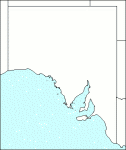|
Epilobium billardieranum
Citation:
Ser. in DC., Prod. 3:41 (1828).
Synonymy: Not Applicable Common name: None
Description:
Perennials with erect to decumbent branches up to 80 cm long, branched mainly from a rhizome-like frequently rooting base, more or less covered with appressed hairs which are sometimes mixed with erect glandular and non-glandular hairs; leaves mainly opposite but often becoming alternate on or near the inflorescence, with a petiole 0-2 mm long; lamina ovate, lanceolate or linear, 0.7-4.5 x 0.2-1.8 cm, acute to obtuse, cordate, truncate to cuneate at the base, serrate to serrulate-dentate, almost glabrous to pubescent.
Inflorescence erect, with flowers single in the axils of leaf-like bracts; pedicels 0.5-2 cm long when fruiting; floral tube to 2 mm long and usually with a ring of hairs at the base of the filaments; sepals linear-lanceolate, 3-7 mm long, densely covered with appressed hairs as well as often with spreading glandular and non-glandular hairs; petals obovate, 3-13 mm long, with a terminal notch up to 2.5 mm deep, white tinged pink or rose-purple; stamens in 2 whorls and of different length; style as long as or shorter than the longer stamens, usually with a somewhat swollen stigma.
Capsule 3.5-7 cm long; seeds densely covered with papillae.
|
Conservation status:
native
Flowering time: No flowering time is available |

SA Distribution Map based
on current data relating to
specimens held in the
State Herbarium of South Australia
|
Biology:
No text
Taxonomic notes:
Before Raven & T. Raven (1976) published their complete revision of the genus in Australasia E. billardieranum and E. cinereum were accepted as distinct species and they are easily distinguished in some regions of eastern Australia and New Zealand. However, in parts of Vic. and S.Aust. hybrids are as common as the putative parents and populations are comparatively stable. These three (ie. the two parental taxa and the hybrids) groups of plants were therefore somewhat arbitrarily distinguished as three subspecies. Although this practical approach is unconventional, it has been used and accepted in Australia.
Key to Infraspecific taxa:
|
1. Inflorescence and fruits without erect glandular and non-glandular hairs |
|
|
|
2. Leaves ovate to almost orbicular; margins regularly dentate-serrate, with 16-40 teeth on each side |
|
subsp. billardieranum 1a. |
|
2. Leaves lanceolate; margins usually irregularly serrate and undulate, with 6-20 teeth on each side |
|
subsp. xintermedium 1c. |
|
1. Inflorescence and fruit with erect glandular and non-glandular hairs |
|
|
|
3. Leaves lanceolate; margins usually irregularly serrate and undulate, with 6-20 teeth on each side |
|
subsp. xintermedium 1c. |
|
3. Leaves linear, rarely linear-elliptic; margins with sidely spaced coarse serrations, i.e. 0-6 teeth on each side |
|
subsp. cinereum 1b. |
Author:
Not yet available
|

